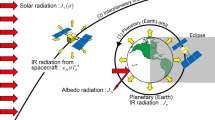Abstract
We describe the in-flight performance of the horn-coupled lumped element kinetic inductance detector arrays of the balloon-borne OLIMPO experiment. These arrays have been designed to match the spectral bands of OLIMPO: 150, 250, 350, and \(460\,\hbox {GHz}\), and they have been operated at \(0.3\,\hbox {K}\) and at an altitude of \({37.8}\,\hbox {km}\) during the stratospheric flight of the OLIMPO payload, in Summer 2018. During the first hours of flight, we tuned the detectors and verified their large dynamics under the radiative background variations due to elevation increase of the telescope and to the insertion of the plug-in room-temperature differential Fourier transform spectrometer into the optical chain. We have found that the detector noise equivalent powers are close to be photon noise limited and lower than those measured on the ground. Moreover, the data contamination due to primary cosmic rays hitting the arrays is less than 3% for all the pixels of all the arrays and less than 1% for most of the pixels. These results can be considered the first step of KID technology validation in a representative space environment.








Similar content being viewed by others
References
J. Delabrouille et al., (CORE collaboration). J. Cosmol. Astropart. Phys. 04, 014 (2018). https://doi.org/10.1088/1475-7516/2018/04/014
P.K. Day et al., Nature 425, 817 (2003). https://doi.org/10.1038/nature02037
S. Doyle et al., J. Low Temp. Phys. 151, 530 (2008). https://doi.org/10.1007/s10909-007-9685-2
M. Calvo et al., Proc. SPIE 8452, 845203 (2012). https://doi.org/10.1117/12.927044
R. Adam et al., Astron. Astrophys. 609, A115 (2018). https://doi.org/10.1051/0004-6361/201731503
A. Coppolecchia et al., New Horizons Obs. Cosmol. (2013). https://doi.org/10.3254/978-1-61499-476-3-257
P. de Bernardis et al., (CORE collaboration). J. Cosmol. Astropart. Phys. 04, 015 (2018). https://doi.org/10.1088/1475-7516/2018/04/015
F. Finelli et al., (CORE collaboration). J. Cosmol. Astropart. Phys. 04, 016 (2018). https://doi.org/10.1088/1475-7516/2018/04/016
E. Di Valentino et al., (CORE collaboration). J. Cosmol. Astropart. Phys. 04, 017 (2018). https://doi.org/10.1088/1475-7516/2018/04/017
A. Challinor et al., (CORE collaboration). J. Cosmol. Astropart. Phys. 04, 018 (2018). https://doi.org/10.1088/1475-7516/2018/04/018
J.-B. Melin et al., (CORE collaboration). J. Cosmol. Astropart. Phys. 04, 019 (2018). https://doi.org/10.1088/1475-7516/2018/04/019
G. De Zotti et al., (CORE collaboration). J. Cosmol. Astropart. Phys. 04, 020 (2018). https://doi.org/10.1088/1475-7516/2018/04/020
C. Burigana et al., (CORE collaboration). J. Cosmol. Astropart. Phys. 04, 021 (2018). https://doi.org/10.1088/1475-7516/2018/04/021
P. Natoli et al., (CORE collaboration). J. Cosmol. Astropart. Phys. 04, 022 (2018). https://doi.org/10.1088/1475-7516/2018/04/022
M. Remazeilles et al., (CORE collaboration). J. Cosmol. Astropart. Phys. 04, 023 (2018). https://doi.org/10.1088/1475-7516/2018/04/023
A. Monfardini et al., Proc. SPIE 9914, 99140N (2016). https://doi.org/10.1117/12.2231758
J.J.A. Baselmans et al., Astron. Astrophys. 601, A89 (2017). https://doi.org/10.1051/0004-6361/201629653
K. Karatsu et al., Appl. Phys. Lett. 114, 032601 (2019). https://doi.org/10.1063/1.5052419
Y.B. Zeldovich, R.A. Sunyaev, Astrophys. Space Sci. 7, 3 (1970). https://doi.org/10.1007/BF00653471
A. Schillaci et al., Astron. Astrophys. 565, A125 (2014). https://doi.org/10.1051/0004-6361/201423631
A. Coppolecchia et al., to be submitted (2019)
P. de Bernardis et al., Astron. Astrophys. 538, A86 (2012). https://doi.org/10.1051/0004-6361/201118062
A. Paiella et al., in 2017 16th International Superconductive Electronics Conference (ISEC)1, (2017). https://doi.org/10.1109/ISEC.2017.8314223
A. Paiella et al., J. Cosmol. Astropart. Phys. 01, 039 (2019). https://doi.org/10.1088/1475-7516/2019/01/039
A. Paiella et al., J. Low Temp. Phys. 184, 97 (2016). https://doi.org/10.1007/s10909-015-1470-z
A. Paiella et al., J. Phys. Conf. Ser. 1182, 012005 (2019). https://doi.org/10.1088/1742-6596/1182/1/012005
O. Noroozian et al., AIP Conf. Proc. 1185, 148 (2009). https://doi.org/10.1063/1.3292302
S. Gordon et al., J. Astr. Inst. 05, 1641003 (2016). https://doi.org/10.1142/S2251171716410038
S. Masi et al., EPJ Web Conf. 209, 01046 (2019). https://doi.org/10.1051/epjconf/201920901046
S. Masi et al., J. Cosmol. Astropart. Phys. 07, 003 (2019). https://doi.org/10.1088/1475-7516/2019/07/003
P. Abbon et al., Nucl. Instrum. Methods A 575, 412 (2007). https://doi.org/10.1016/j.nima.2007.02.094
S. Masi et al., Astron. Astrophys. 519, A24 (2010). https://doi.org/10.1051/0004-6361/201014065
Acknowledgements
This activity has been supported by the Italian Space Agency.
Author information
Authors and Affiliations
Corresponding author
Additional information
Publisher's Note
Springer Nature remains neutral with regard to jurisdictional claims in published maps and institutional affiliations.
Rights and permissions
About this article
Cite this article
Paiella, A., Ade, P.A.R., Battistelli, E.S. et al. In-Flight Performance of the LEKIDs of the OLIMPO Experiment. J Low Temp Phys 199, 491–501 (2020). https://doi.org/10.1007/s10909-020-02372-y
Received:
Accepted:
Published:
Issue Date:
DOI: https://doi.org/10.1007/s10909-020-02372-y




